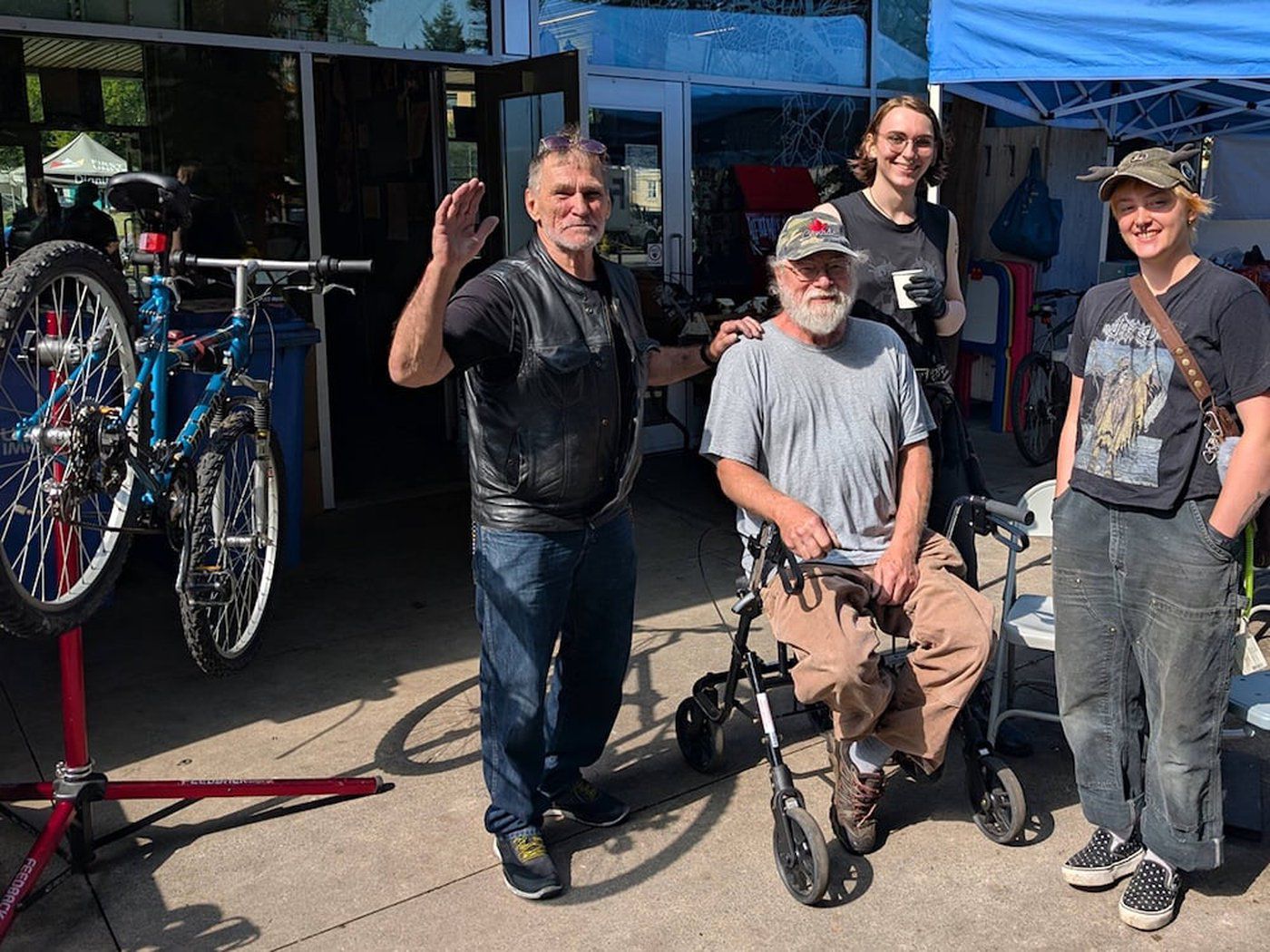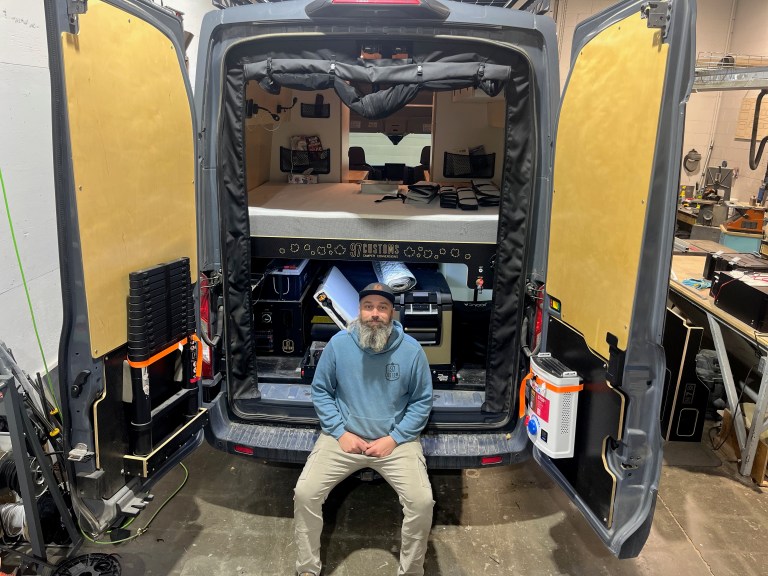

Tucked into the corner of Oppenheimer Park in Vancouver is a free pop-up bike shop that services a wide range of mobility devices every Tuesday and Sunday.
People bring in bicycles, wheelchairs, walkers, shopping carts, hand truck dollies, vacuums and more, and Our Community Bikes’ mechanics help people fix their own equipment, or step in and do the repairs for them.
In general, tires and wheels that move on bearings are pretty similar, so “if you’re mechanically minded it’s not super hard to figure out,” said Agnes Pedersen, a junior mechanic who has been working at the free repair clinic for three years.
The challenge is finding and storing all the necessary replacement parts.
For wheelchairs and mobility devices, “the standard is there is no standard,” Pedersen said — meaning there’s an incredible amount of variability in the industry.
This can allow wheelchairs to be customized to suit a user’s body, disability and even their home measurements. But it creates a headache when it comes to maintenance and repairs because pieces are more specific and proprietary.
Missing replacement parts are not the only thing causing delays.
Unfortunately, there is no simple solution to this complex situation, William Miller, a professor of occupational science and occupational therapy in the faculty of medicine at the University of British Columbia, told The Tyee.
But there are several smaller actions people in B.C. can take to improve things.
Scheduling maintenance, making parts more accessible
Scheduled annual maintenance would likely catch around 80 per cent of problems, such as worn tires or corroded batteries, before a wheelchair actually broke down, Miller said, adding that “prevention is key.”
Manufacturers, who make parts, and vendors, who sell and repair mobility devices, could also do more to help users buy parts and take on repairs themselves, said Andrew Gillis, who uses a manual wheelchair, lives in Vancouver and used to work as a bike mechanic.
“A lot of these products are sold with the expectation that the person who uses it isn’t in a position to do maintenance themselves, which cuts out the end-user,” Gillis said. “That feels really disempowering.”
That doesn’t mean users should have to do their own maintenance, Gillis continued, because some people might not have the know-how or the physical ability to do their own repairs.
The wheelchair industry could learn something from the bike industry, where a lot of work has gone into making parts that are high-quality, long-lasting and easy to maintain, Gillis said.
Proprietary parts, Gillis added, should be discouraged.
Bike shops could likely help with repairs if customers were able to bring replacement parts in that they’d ordered, Pedersen said.
The Tyee sent interview requests to several wheelchair vendors in the Lower Mainland and heard back from only one owner, who said he’d agree to an interview only if he could be anonymous.
Greg Hamada, a pseudonym, said the government could also reduce delays if it set up lists of pre-approved services, parts or repairs for set periods of time, for example if everyone was entitled to a new set of tires each year.
Vendors could also do more work to encourage customers to buy generic parts, which might not come with a name brand or in the colour they want but can be of just as high quality, he said. This could help vendors build an on-hand stock of reliable pieces to do repairs with.
Creating a second-hand market
Jocelyn Maffin, associate director for Spinal Cord Injury BC, said the creation of a second-hand market could help reduce manufacturer backlogs and help people source parts for wheelchairs that have been discontinued.
The mechanics at Our Community Bikes’ free repair shop said they’re offered second-hand devices all the time, but they don’t have anywhere to store them.
Another problem is that second-hand parts don’t come with the same guarantees as a new product, so people can be hesitant to use them, Maffin said.
UBC’s Miller said he used to work with a depot in Barrie, Ontario, in the 1990s that had an inventory of slightly-to-well-used mobility devices.
It worked “moderately well,” he said.
Miller said he’s in the early stages of recreating a similar depot in Ontario but still isn’t sure if it will be economically feasible.
Digital portal for coverage and claims
Hamada said he’d like to find the money to build an online portal, or have the government make a portal where vendors could easily check a customer’s coverage and submit claims, or customers could check for updates.
The industry still largely operates via phone calls and mail, meaning it can take half an hour to figure out if a customer even has coverage, he said.
Technicians’ time is finite and in high demand, Hamada said. Spending 30 minutes on the phone for one customer means you’re taking time away from other customers.
Miller said a portal “is not a bad solution but is not going to solve all the problems.”
For example, the approval process for repairs might still be backlogged if government employees were still underfunded and stretched thin, he said.
Miller said he was part of a project that created a similar portal in Quebec, but it never really took off because people were reluctant to shift into a new system.
More money for the ministries
To improve the overall system the government needs a bigger budget, Miller said.
It’s just like any other kind of health care, he said, adding that “more money is needed to provide a better service.”
This could help speed up the approval process with the ability to hire more government employees, which could reduce business delays, letting companies hire more employees to meet service and repair demands, he said.
More funding could also be used to improve the quality and scope of the equipment people get, he said.
The ministries “only fund basic mobility, which is pretty confined when it comes to meeting people’s needs,” Miller said. “These mobility devices are on a minimalist model to provide individuals with mobility in their home and at best around their neighbourhood.”
“A relaxation of these minimalist guidelines” is needed, Miller said.

If companies are struggling to meet demand, they need to band together and advocate for a different system, said wheelchair user Olivia Locke, who spoke with The Tyee for Part 1 of this series.
People who use wheelchairs and mobility equipment are a captive audience, she added, because they can’t take their business elsewhere or refuse to use the products or service. That makes it very hard for customers to push for change, she said.
Bill for travel time
Service providers often work with clients in a broad geographical range. For example, their business may be headquartered in Surrey but they service mobility devices for people in Hope, or they could service everyone from Barriere to Osoyoos, Miller said.
Service providers will send technicians to someone’s home to assess their mobility device and generate a quote for repairs. Technicians have to send the quote to the government and wait for approval before they do any repairs. Because the government will not cover the cost of repairs if a technician doesn’t follow this process, and because the government doesn’t cover the cost of travel time for technicians, this can create a significant extra cost for businesses.
Letting businesses charge for technicians’ travel time has “some credibility” as a solution, Miller said, and might help businesses hire more people to cover their large service areas.
Boosting competition
Creating competition in a relatively small market with small profit margins is tough, Miller said.
Allowing customers to purchase parts from overseas retailers might be a solution, Maffin said.
Maffin said she bought a SmartDrive, a device built by Permobil, a company headquartered in Sweden, for $8,000 and then had to pay an extra $3,000 in repairs when her device broke down eight times in three years. At the same time, she said, a friend bought a similar device online from a Chinese retailer for $500, and it hasn’t broken down once.
Maffin also said she’d like the industry to make it easier for customers to move between companies — but added that won’t change much until the systemic issues facing the industry are addressed.
While customers are allowed to take their business anywhere, they will get only two years of free service from the company that sold them the item, the Ministry of Social Development and Poverty Reduction told The Tyee.
Customers can also pay out of pocket for repairs, which can speed up the process, Miller said.
People covered by private insurance can pay for services and get reimbursed later. Those covered by ICBC or WorkSafeBC can generally get approved after they call their case manager.
People whose devices and repairs are funded by a ministry have to wait weeks or a month for approval before repairs can be done, and won’t get reimbursed if they pay to skip the line, Miller said.
Investing now, saving later
Miller and Hamada both said investing in mobility devices saves the government money in the long run.
Pressure wounds can quickly develop when a person is stuck in bed or has a problem with a part of their wheelchair that touches their body, such as a cushion.
That creates a “substantial cost” right away, both to the person’s quality of life and to society, Miller said.
He said that in terms of health-care costs, healing a pressure wound can cost $50,000.
“Depending on the stage of the pressure wound, it can cause death, too, in cases where infection sets in,” he said.
Hamada said people are more likely to get stuck in bed or have issues with their equipment if the government funds cheap equipment, which breaks down more often.
In addition to speeding up repair approvals, technicians could also potentially triage repairs so that patients who are at high risk of complications can be seen first, Miller said.
Ultimately something needs to change, said Gillis. The situation is already intolerable and is only going to get worse as the population ages.
A wheelchair is “a machine that is part of my body,” Gillis said, adding it’s not acceptable that people who use wheelchairs have to wait weeks or even months to get something that is as important as a pair of legs repaired.
If the private sector isn’t able to meet the current demand, then maybe the government needs to step in and nationalize the whole industry, Gillis said.
— This story was original published by The Tyee
Join the Conversation!
Want to share your thoughts, add context, or connect with others in your community?
You must be logged in to post a comment.














